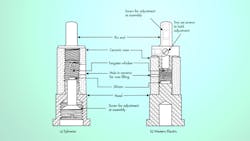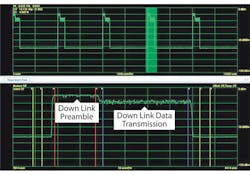This file type includes high resolution graphics and schematics when applicable.
Power is important. Measuring the power from an RF/microwave signal is a fundamental way to gain knowledge about signals and devices. Understandably, it is critical to accurately and consistently measure power. It also is essential to maintain a standard of power measurement that enables measured power to be communicated to customers, manufacturers, designers, and researchers. There are three main technologies involved in measuring RF/microwave power: the diode, thermistor, and thermocouple sensor. Each product type comes with its own benefits and uncertainties. Additionally, industry and manufacturer standards for power-measurement calibration need to be employed successfully to communicate absolute values of power (namely, the National Institute of Standards and Technology and other National Measurement Institutes). Having a clear understanding of the fundamentals of power measurement, including the technology and standards, will ensure that an engineer has the most reliable information for optimizing their designs.
The goal of a power sensor, for example, is to absorb the incoming energy from an RF/microwave signal. By relying on energy conversion, it then attempts to transfer that energy into usable electrical energy that exactly replicates the absorbed energy. Of course, some energy is always lost in the impedance mismatch between the source and sensor. In addition, some energy is absorbed in parts of the sensor that do not render usable electrical energy. The meter itself also suffers from some conversion inefficiencies. Fortunately, however, there are calibrations provided by power-meter manufacturers that use a chart or built-in memory to help compensate for the sensor and meter inefficiencies.
An Old-Timey Thermistor
Of the three types of sensor technologies, the thermistor—a type of bolometer—has been around the longest. It is still used in many applications including science and research. The thermistor sensor converts RF/microwave energy received by a semiconductor-based material, which changes resistance as a function of temperature (Fig. 1). In addition, a feedback loop is used with a balanced-bridge typology. That typology employs a direct-current (DC) or alternating-current (AC) bias supply as a control to maintain a constant resistance for the sensor. As a result, the changes in bias power can be used as an indicator for the energy absorbed in the sensor.
Lower Error with Thermocouple Sensors
In many of today’s applications, thermocouple sensors have replaced thermistors. This trend is most likely due to the advantages offered by thermocouple sensors: higher dynamic range, sensitivity, increased durability, and lower measurement uncertainties associated with standing wave ratio (SWR). Thermocouple operation relies on two physical bases—the first of which uses the voltage generated from the Peltier effect at the junction of two electrically dissimilar materials. The other base leverages the Thomson effect at the junction of two different temperature sections of a conductor. Currently, metallic thin-film and semiconductor technology are used to create high-performing and linear thermocouples in very small footprints.
A transmission method is often employed to enable use of the extremely low voltage—sometimes as low as 1 nV/mW—generated by the thermocouple. One method is to chop the DC signal into a series of square waves and transmit that over an AC-coupled path after amplification(Fig. 2). Because this is an open-loop approach, an outside calibration method must be used. Otherwise, various aspects of the thermocouple sensor can lead to drift in the DC response to RF/microwave power. Often, a highly accurate reference oscillator set to a specific known power is used between tests to calibrate the thermocouple-based sensor to match the reference source. Errors in the reference source, calibration mechanisms, or interconnect of the source and sensor can lead to measurement errors. It is therefore critical for the reference to have as little error as possible as well as a verifiable trace history to a credible NMI.
This file type includes high resolution graphics and schematics when applicable.
Diodes!
This file type includes high resolution graphics and schematics when applicable.
Another power-measuring technology that is becoming more viable is the diode detector. The nonlinear current and voltage relationship within a diode, which stems from the junction properties, allows the flow of current through a particular path of the device. At the same time, it resists the flow of current in the opposite direction. This behavior makes it possible to derive a positive waveform using multiple diodes—a process known as rectification. Diode technologies, such as low-barrier-shottky (LBS) and planar-doped-barrier (PDB) diodes, have very low internal capacitance and low forward voltage. As a result, they can respond well to very rapidly changing signals (Fig. 3). With advanced micro-fabrication techniques, these devices can be produced with a high level of consistency and reliability at relatively low costs. Although many diode detectors are limited in the higher power regimes—beyond the -20 dBm level in which thermocouple sensors can accurately operate—diode sensors are often capable of accurate sensing down to -70 dBm. Thus, they are often chosen for high-sensitivity and high-frequency power measurements.
The resistance at the terminal of an LBS diode is high for low-signal levels and varies significantly with temperature. Consequently, additional matching circuitry may be required to achieve reliable results. PDB diodes generally have consistent and much lower resistances than LBS diodes. They also boast lower internal capacitance, which leads to more stable square-law region behavior and a higher operating range.
With enhanced fabrication techniques, some diode sensors have reached 90 dB in dynamic range. This range is suitable for continuous-wave (CW) sensing into the millimeter-wave frequencies. Additional circuitry can be added to the diode power sensor on a monolithic-microwave-integrated-circuit (MMIC) substrate, which will allow advanced corrections to be applied to further increase the diode-sensor device performance. To enable averaging power measurements, it is possible to use a high-sensitivity and low-sensitivity path connected to a splitter and then to the source (Fig. 4).
Error & Uncertainty
To maintain a common ground for power-measurement standards, NMI organizations have prescribed methods of obtaining calibration-standard traceability. These standards often start with extremely accurate micro-calorimeter standards. They are then transferred to working standards and on to measurement reference standards used by commercial standards laboratories. From there, they are transferred to manufacturing facilities and lastly to test equipment.
Each stage in the standards-transfer process adds error, which is compounded by the sensor, meter, and mismatch error present in the power meter. Often, a power-splitter technique is used with a reference power meter and a power meter awaiting calibration. This approach, known as the power-ratio method, allows the power meters to be adjusted to relatively equivalent operation. Yet the asymmetries in the splitter calibration often add more error to the meter. More complex methods are needed to appropriately calibrate a peak-power sensor, as the micro-calorimeter sensor is an averaging sensor base.
To achieve the lowest error possible for any of the measurement technologies, it is critical to account for the error in each stage of the sensor and meter process. Precision assemblies can help to reduce the impedance mismatch between the sensor and source. In addition, multiple sensors can sometimes be used to mitigate the effects of bias, ambient temperature, and noise factors.
A variety of power-measurement technologies extend from bench-top to rack-mount power-measurement devices. Network analyzers, spectrum analyzers, and many other test and measurement instruments utilize power sensors in order to translate RF/microwave signals into human-relatable terms. One must keep in mind that the different techniques, technologies, and methods of power sensing may be better suited to measuring different power levels, frequencies, and modulations of signals. As a result, having a deep understanding of the exact signals under scrutiny and available measurement techniques could aid in delivering an adequate quality result.
This file type includes high resolution graphics and schematics when applicable.
About the Author
Jean-Jacques DeLisle
Jean-Jacques graduated from the Rochester Institute of Technology, where he completed his Master of Science in Electrical Engineering. In his studies, Jean-Jacques focused on Control Systems Design, Mixed-Signal IC Design, and RF Design. His research focus was in smart-sensor platform design for RF connector applications for the telecommunications industry. During his research, Jean-Jacques developed a passion for the field of RF/microwaves and expanded his knowledge by doing R&D for the telecommunications industry.





